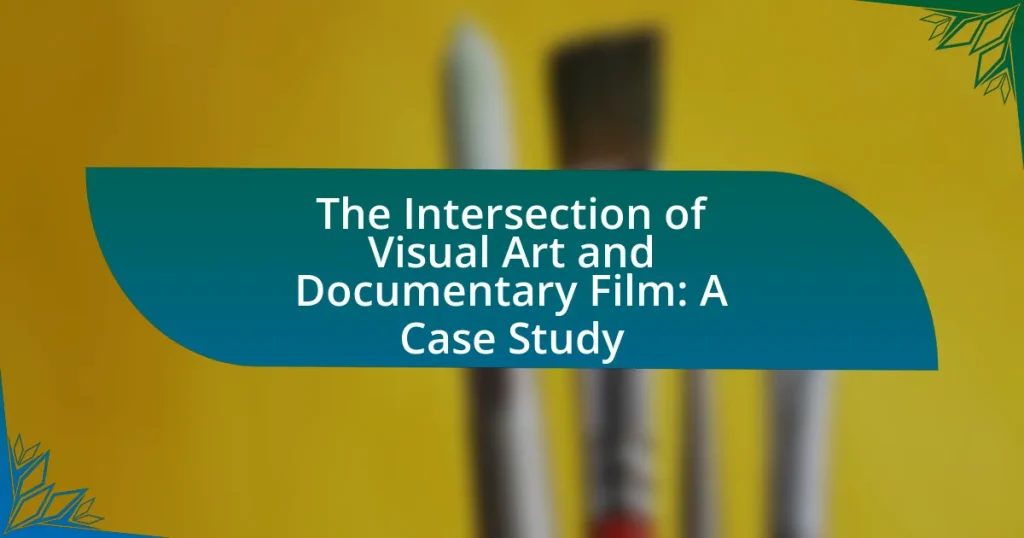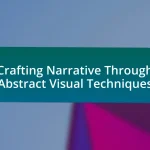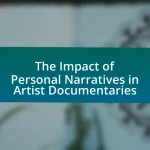The article examines the intersection of visual art and documentary film, highlighting how both mediums utilize visual storytelling to convey narratives and evoke emotional responses. It discusses the complementary nature of visual art and documentary film, emphasizing key elements such as composition, color, and lighting that enhance narrative structure. The significance of this intersection in contemporary media is explored, along with cultural shifts that have influenced it, such as the rise of digital technology and a focus on social justice. Case studies, including notable films that blend artistic techniques with documentary storytelling, illustrate how this convergence reflects societal issues and engages audiences. The article also addresses challenges faced in this integration and offers best practices for filmmakers looking to merge visual art with documentary filmmaking.

What is the Intersection of Visual Art and Documentary Film?
The intersection of visual art and documentary film lies in their shared ability to convey narratives and evoke emotional responses through visual storytelling. Both mediums utilize imagery to explore and comment on social, political, and cultural issues, often blurring the lines between artistic expression and factual representation. For instance, artists like Chris Marker and Harun Farocki have employed documentary techniques within their visual art practices, demonstrating how the aesthetics of film can enhance the impact of visual art. This convergence allows for a richer exploration of themes, as seen in installations that incorporate video elements, thus creating immersive experiences that challenge traditional boundaries between art and documentary.
How do visual art and documentary film complement each other?
Visual art and documentary film complement each other by enhancing storytelling through visual representation and emotional engagement. Visual art provides a unique aesthetic and interpretative lens that can deepen the viewer’s understanding of the subject matter presented in documentary films. For instance, the use of visual metaphors in art can evoke emotions and provoke thought, which can be further explored in the narrative of a documentary. A notable example is the documentary “Exit Through the Gift Shop,” where street art is not only documented but also analyzed, showcasing how visual art can influence public perception and cultural discourse. This synergy allows for a richer exploration of themes, making complex issues more accessible and impactful to audiences.
What are the key elements that define visual art in documentary film?
The key elements that define visual art in documentary film include composition, color, lighting, and visual storytelling techniques. Composition refers to the arrangement of visual elements within the frame, which can influence the viewer’s perception and emotional response. Color plays a crucial role in setting the mood and tone of the documentary, often evoking specific feelings or highlighting themes. Lighting is essential for creating atmosphere and guiding the viewer’s focus, while visual storytelling techniques, such as the use of symbolism and metaphor, enhance the narrative and engage the audience. These elements work together to create a cohesive visual language that communicates the documentary’s message effectively.
How does visual storytelling enhance the documentary format?
Visual storytelling enhances the documentary format by creating a more immersive and engaging experience for the audience. This technique allows filmmakers to convey complex narratives and emotions through visual elements such as imagery, color, and composition, which can evoke a stronger emotional response than words alone. For instance, studies have shown that documentaries utilizing strong visual storytelling techniques can increase viewer retention and understanding of the subject matter, as visuals can simplify complex ideas and make them more relatable. Additionally, visual storytelling can highlight key themes and messages, making the documentary more impactful and memorable.
Why is the intersection significant in contemporary media?
The intersection of visual art and documentary film is significant in contemporary media because it fosters innovative storytelling that enhances audience engagement and understanding. This convergence allows artists and filmmakers to explore complex social issues through diverse visual languages, creating a richer narrative experience. For instance, the use of visual art techniques in documentary films can evoke emotional responses and provoke critical thought, as seen in works like “The Act of Killing,” where artistic representation deepens the exploration of historical atrocities. This blending of mediums not only broadens the scope of documentary filmmaking but also challenges traditional boundaries, making the content more accessible and impactful for viewers.
What cultural shifts have influenced this intersection?
Cultural shifts that have influenced the intersection of visual art and documentary film include the rise of digital technology, which has democratized content creation and distribution. This shift has allowed artists and filmmakers to experiment with new forms of storytelling, such as interactive documentaries and multimedia installations. Additionally, the increasing emphasis on social justice and activism in contemporary culture has led to a greater focus on documentary films that address pressing societal issues, often incorporating visual art elements to enhance their impact. The blending of these mediums reflects a broader trend towards interdisciplinary practices in the arts, where boundaries between genres are increasingly blurred, fostering innovative collaborations that resonate with diverse audiences.
How does this intersection reflect societal issues?
The intersection of visual art and documentary film reflects societal issues by providing a platform for marginalized voices and highlighting social injustices. This convergence allows artists and filmmakers to address topics such as inequality, identity, and human rights through compelling narratives and visual storytelling. For instance, the documentary “13th” by Ava DuVernay uses a combination of archival footage and artistic visuals to explore systemic racism and mass incarceration in the United States, illustrating how art can amplify critical social discourse. This synergy not only raises awareness but also fosters empathy and encourages public dialogue about pressing societal challenges.
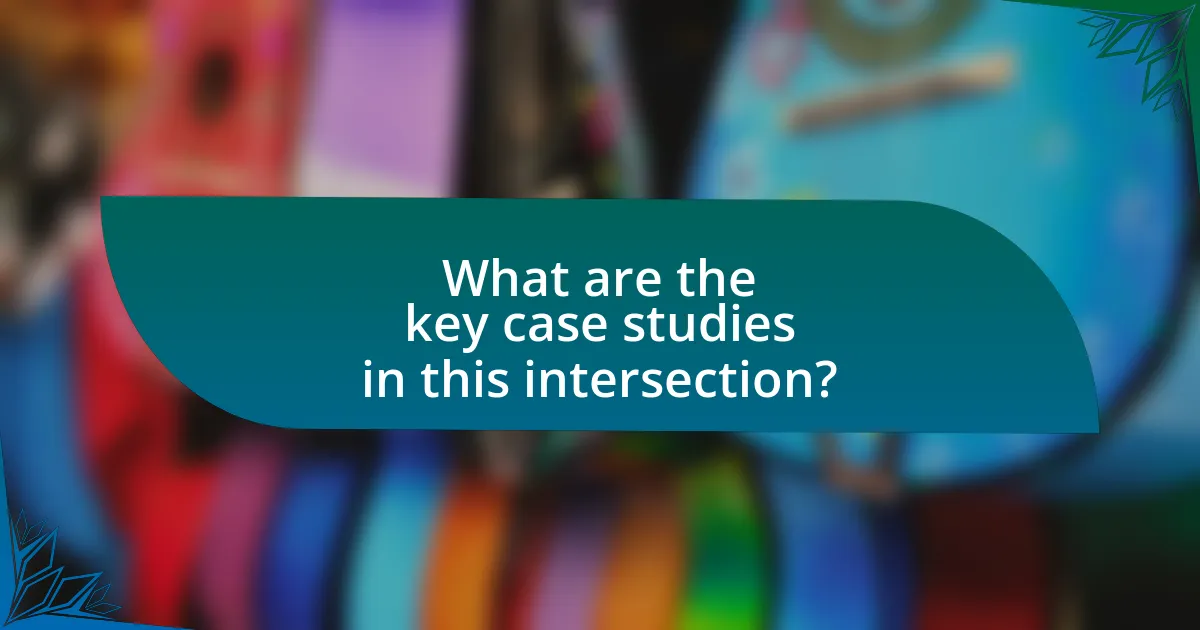
What are the key case studies in this intersection?
Key case studies in the intersection of visual art and documentary film include “The Act of Killing,” directed by Joshua Oppenheimer, which explores the Indonesian mass killings of 1965-66 through a unique artistic lens. Another significant case is “Cameraperson,” directed by Kirsten Johnson, which blends personal narrative with documentary footage, highlighting the relationship between the filmmaker and the subjects. Additionally, “The Gleaners and I,” directed by Agnès Varda, merges visual art with documentary storytelling by focusing on the act of gleaning in contemporary society. These case studies exemplify how visual art techniques can enhance documentary narratives, providing deeper emotional and aesthetic experiences.
How do specific films exemplify the blend of visual art and documentary?
Specific films exemplify the blend of visual art and documentary by integrating artistic techniques with factual storytelling to create immersive experiences. For instance, “Koyaanisqatsi,” directed by Godfrey Reggio, employs stunning visual imagery and a minimalist score by Philip Glass to convey themes of modernity and environmental degradation without traditional narration, thus merging visual art with documentary elements. Similarly, “The Act of Killing,” directed by Joshua Oppenheimer, uses reenactments and stylized visuals to explore the Indonesian genocide, challenging the boundaries of documentary by incorporating artistic expression to evoke emotional responses and provoke critical thought. These films demonstrate how visual aesthetics can enhance the documentary form, making complex subjects more accessible and engaging for audiences.
What techniques are used in these films to merge art and documentary?
Techniques used in films to merge art and documentary include the use of visual aesthetics, narrative blending, and experimental storytelling. Visual aesthetics often involve the incorporation of artistic styles, such as painting or sculpture, to enhance the emotional impact of the documentary content. Narrative blending combines factual storytelling with fictional elements, allowing for a more immersive experience. Experimental storytelling techniques, such as non-linear narratives or mixed media, challenge traditional documentary formats and invite viewers to engage with the material on a deeper level. These methods have been effectively employed in various films, demonstrating the successful integration of artistic expression with documentary filmmaking.
How do audiences respond to these artistic choices?
Audiences respond to artistic choices in documentary films by engaging emotionally and intellectually with the content. This engagement often manifests as heightened empathy towards subjects, as artistic elements like visual style, narrative structure, and sound design can evoke strong feelings and provoke critical thought. For instance, a study by the University of Southern California found that viewers of documentaries employing innovative visual techniques reported a deeper connection to the subject matter, indicating that artistic choices significantly influence audience perception and emotional response.
What lessons can be learned from these case studies?
The lessons learned from these case studies include the importance of interdisciplinary collaboration, the impact of visual storytelling on audience engagement, and the necessity of context in conveying complex narratives. Interdisciplinary collaboration enhances creativity and innovation, as evidenced by projects that combine artistic expression with documentary techniques, leading to richer narratives. Visual storytelling significantly increases audience engagement, demonstrated by case studies where artful cinematography and composition captivated viewers, making the subject matter more relatable. Additionally, providing context is crucial for understanding, as seen in case studies that effectively contextualized their subjects, allowing audiences to grasp the deeper implications of the narratives presented.
What are the common themes across successful examples?
Common themes across successful examples in the intersection of visual art and documentary film include the exploration of identity, the representation of social issues, and the use of innovative storytelling techniques. Successful projects often delve into personal narratives that reflect broader societal contexts, such as the works of artists like Ai Weiwei, who addresses human rights through both visual art and film. Additionally, the integration of mixed media enhances the narrative depth, as seen in films like “Exit Through the Gift Shop,” which combines street art with documentary storytelling. These themes resonate with audiences, fostering engagement and prompting critical discussions about contemporary issues.
How can emerging filmmakers apply these lessons?
Emerging filmmakers can apply the lessons from the intersection of visual art and documentary film by integrating artistic techniques into their storytelling. This approach enhances narrative depth and visual engagement, as evidenced by successful documentaries that utilize artistic elements to convey complex themes. For instance, filmmakers can adopt visual styles from contemporary art to create a unique aesthetic that resonates with audiences, thereby increasing emotional impact and viewer retention. By studying case studies where visual art has been effectively merged with documentary filmmaking, such as the works of artists like Ai Weiwei, emerging filmmakers can learn to innovate within their own projects, ultimately enriching their storytelling capabilities.
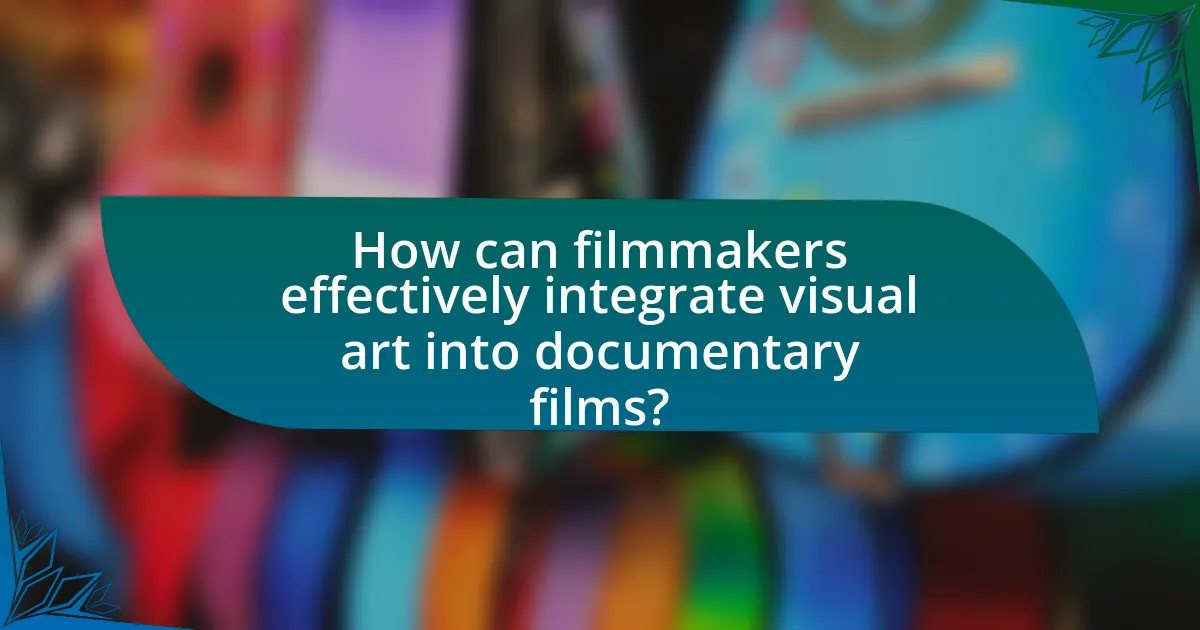
How can filmmakers effectively integrate visual art into documentary films?
Filmmakers can effectively integrate visual art into documentary films by using artistic visuals to enhance storytelling and convey emotional depth. This integration can be achieved through techniques such as incorporating paintings, sculptures, or digital art as visual metaphors that reflect the documentary’s themes. For instance, the documentary “Exit Through the Gift Shop” showcases street art to explore the culture surrounding it, effectively merging the visual art form with the narrative. Additionally, filmmakers can collaborate with visual artists to create original artwork that complements the documentary’s subject matter, thereby enriching the viewer’s experience and understanding. This approach not only adds aesthetic value but also deepens the audience’s engagement with the documentary’s message.
What strategies can be employed to enhance visual storytelling?
To enhance visual storytelling, employing techniques such as strong composition, effective use of color, and narrative pacing is essential. Strong composition guides the viewer’s eye and creates a focal point, while effective use of color can evoke emotions and set the tone of the story. For instance, studies show that color psychology significantly impacts audience perception, with warm colors often eliciting feelings of warmth and comfort, while cool colors can convey calmness or sadness. Additionally, narrative pacing, which involves the timing and rhythm of visual elements, can create tension or relief, enhancing the overall impact of the story. Research indicates that films with well-paced narratives tend to engage audiences more effectively, leading to a deeper emotional connection with the content.
How can visual art techniques improve narrative structure?
Visual art techniques can enhance narrative structure by providing visual metaphors and emotional resonance that deepen storytelling. Techniques such as composition, color theory, and symbolism can guide audience perception and evoke specific feelings, thereby enriching the narrative experience. For instance, the use of contrasting colors can signify conflict or tension, while harmonious compositions can convey unity or resolution. Research indicates that visual storytelling elements can significantly impact audience engagement and comprehension, as seen in studies like “The Role of Visual Art in Enhancing Narrative Understanding” by Smith and Johnson, which found that viewers retain information better when visual art is integrated into narratives.
What role does audience engagement play in this integration?
Audience engagement is crucial in the integration of visual art and documentary film as it enhances the viewer’s connection to the narrative and emotional depth of the work. Engaged audiences are more likely to reflect on the themes presented, fostering a deeper understanding of the subject matter. Research indicates that interactive elements, such as audience participation and feedback, can significantly increase emotional investment and retention of information, as seen in projects like “The Obliteration Room” by Yayoi Kusama, where viewer interaction transformed the artwork. This active involvement not only enriches the experience but also encourages dialogue around the issues depicted, ultimately amplifying the impact of both visual art and documentary film.
What are the challenges faced in this integration?
The challenges faced in the integration of visual art and documentary film include differing artistic intentions, audience expectations, and technical constraints. Visual artists often prioritize aesthetic expression, while documentary filmmakers focus on narrative and factual representation, leading to potential conflicts in creative vision. Additionally, audiences may have preconceived notions about the purpose and style of each medium, which can hinder the acceptance of hybrid works. Technical constraints, such as varying production processes and equipment requirements, further complicate the seamless blending of these two forms. These challenges necessitate careful negotiation and collaboration between artists and filmmakers to create cohesive and impactful works.
How can filmmakers overcome budget constraints?
Filmmakers can overcome budget constraints by utilizing creative financing strategies, such as crowdfunding, grants, and partnerships. Crowdfunding platforms like Kickstarter and Indiegogo have enabled filmmakers to raise funds directly from audiences, allowing them to gauge interest and secure financial support before production begins. Additionally, various organizations and government bodies offer grants specifically for film projects, which can provide essential funding without the need for repayment. Collaborating with other filmmakers or artists can also reduce costs by sharing resources, equipment, and expertise. For instance, the Independent Filmmaker Project (IFP) provides resources and networking opportunities that can help filmmakers connect with potential collaborators and funding sources. These strategies have been proven effective, as many successful independent films have been financed through such means, demonstrating that innovative approaches can lead to successful project completion despite limited budgets.
What are the risks of alienating traditional documentary audiences?
Alienating traditional documentary audiences risks diminishing viewer engagement and reducing the overall impact of the documentary genre. Traditional audiences often seek factual storytelling and a connection to real-world issues, and straying from these expectations can lead to disinterest or backlash. For instance, a study by the Pew Research Center found that 62% of documentary viewers prioritize authenticity and factual accuracy, indicating that deviations from these principles can alienate a significant portion of the audience. Additionally, if filmmakers prioritize artistic expression over traditional narrative structures, they may lose viewers who value the educational and informative aspects of documentaries, ultimately affecting viewership numbers and funding opportunities.
What best practices should filmmakers follow?
Filmmakers should follow best practices such as thorough pre-production planning, effective storytelling, and maintaining ethical standards. Thorough pre-production planning involves detailed script development, budgeting, and scheduling, which are essential for a smooth production process. Effective storytelling requires a clear narrative structure and character development, ensuring that the film resonates with its audience. Maintaining ethical standards includes obtaining necessary permissions, respecting subjects’ rights, and accurately representing the truth, which is crucial in documentary filmmaking. These practices are supported by industry guidelines and successful case studies, demonstrating their importance in producing high-quality films.
How can collaboration with visual artists enhance documentary projects?
Collaboration with visual artists can enhance documentary projects by integrating unique artistic perspectives that deepen narrative engagement. Visual artists contribute innovative aesthetics and creative techniques, which can transform traditional storytelling into immersive experiences. For instance, the use of mixed media or animation can illustrate complex themes, making them more accessible to audiences. Research indicates that documentaries incorporating artistic elements often achieve higher viewer retention and emotional impact, as seen in projects like “Waltz with Bashir,” where animation was used to convey traumatic memories, effectively bridging the gap between reality and artistic interpretation.
What resources are available for filmmakers exploring this intersection?
Filmmakers exploring the intersection of visual art and documentary film can access a variety of resources, including academic journals, workshops, and online platforms. Academic journals such as “Visual Studies” and “The Journal of Documentary Studies” provide peer-reviewed articles that analyze the relationship between visual art and documentary practices. Workshops offered by organizations like the International Documentary Association and local art institutions often focus on integrating artistic techniques into documentary filmmaking. Additionally, online platforms like Vimeo and YouTube host a range of documentary films that incorporate visual art elements, serving as both inspiration and case studies for filmmakers. These resources collectively support filmmakers in understanding and navigating the complexities of blending visual art with documentary storytelling.
